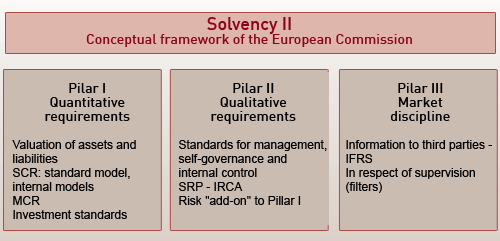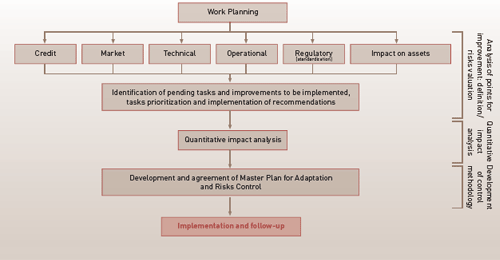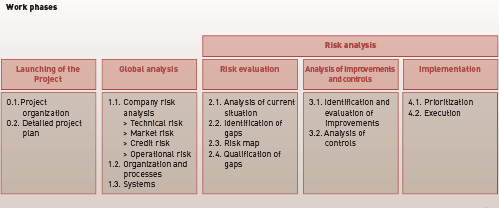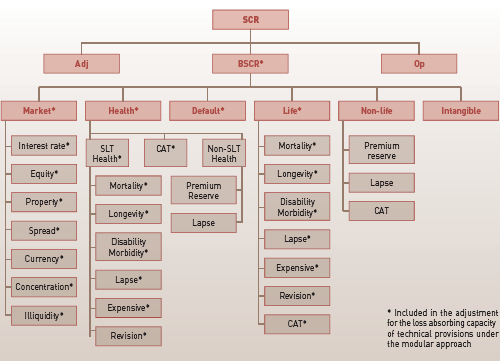Solvency II, an opportunity that should be seizedFINANCIAL
Santiago Romera. Managing Partner of AREA XXI
Madrid - Spain
Basics of Solvency II
First of all, we would like to express our gratitude for the opportunity that has been offered to us to take part in this publication by contributing an article on Solvency II. For this purpose, a three-fold approach would seem to be appropriate:
- In the first section and while we do not intend to focus entirely on theoretical aspects, we shall single out certain fundamental concepts that are necessary in order to understand the “special language” of Solvency II.
- This will be followed by a second, highly practical section which describes the principal milestones in a Master Plan for implementing the regulations bearing in mind (as a primary consideration) that financial markets are not particularly stable at present.
- Consequently, we shall then examine a third aspect namely the opportunities that arise from the standard, emphasizing how a reinsurance company can ultimately benefit from them.
If this three-fold treatment enables us to take a highly practical approach to certain concepts that call for clarification, then the objective that was set on tackling this challenge will have been achieved, given that the composition of an article always starts from… a blank page.
Basel II defines a banking system with adequate capital reserves that will enable it to weather the storms that the economic climate can bring
To conclude this introduction, one final point should be noted and that is “information overload”. If the subject examined in this article is entered in a search engine, it is possible to find up to 2,612,000 references (on the date of writing the present article).
As a starting point, let us summarize the basic knowledge required in order to understand this “special language”:
Origins
To understand the origins of Solvency II and its language, we must refer back to our fellow player in the financial sector, i.e. the banking industry, and more specifically to Basel II. This standard defines a banking system with adequate capital reserves that will enable it to weather the storms that the economic climate can bring. It is more solid and more sensitive to risk than the system under Basel I.
To understand the origins of Solvency II and its language, we must refer back to our fellow player in the financial sector, and more specifically to Basel II
The elements of the new accord are arranged in three pillars which, when broken down and adapted to Solvency II, are as follows:
- Pillar I: Quantitative: Risk considerations assigned to different types of risk assets. These include operational risks. The aim is to determine the “economic balance sheet”, focused on risk and based on market value.
- Pillar II: Qualitative: Ongoing supervision by the regulatory organizations.
- Pillar III: Market discipline based on greater transparency and aiming for international accounting standards, taking IFRS (International Financial Reporting Standards) into account.

Figure 1. Conceptual framework of Solvency II. Three Pillars
SCR: Standard Capital Requirement for Solvency
MCR: Minimum Capital Requirement
IRCA: Internal Risk and Capital Assessment
SRP: Supervisory Review Procedures
Source: CEIOPS [Committee of European Insurance and Occupational Pensions Supervisors] Fuente: CEIOPS
Approach
In essence, the insurance business may be summarized as follows: the payment of a specific sum by the insured (the premium) to a concrete entity (the insurance company) with the purpose of “transferring” the risk to which the insured is exposed. In return, the insurance company accepts the risk, providing cover for it and thereby “releasing” the insured from that risk.
To enable insurers to cope with the foreseeable contingencies, they may have two resources, each of which entails a series of risks:
- The first resource, coming from the insureds,
is the premium that is efficiently collected. This
also entails a “technical risk” as to whether this
premium will be adequate, given that competitive
aspects must also come into play if the premium
is to appear attractive to the customer.
This resource is increased by the degree of financial profitability corresponding to the premium investment until the potential claim occurs. And this, in turn, involves risks attaching to the assets in which the investment is made, such as price fluctuations, market risk and creditworthiness, depending on where it is decided to invest. - A second resource, originating from the shareholders, is the minimum equity capital (shareholder capital) which an insurance company must have (the Solvency Margin) in order to avoid unfavourable fluctuations in the claims ratio by responding to such variations with the aforementioned capital.
At present, the referred Solvency Margin is determined according to the volume of premiums or claims and -in certain lines of businessaccording to the volume of the mathematical (actuarial) reserves or sums at risk. The salient point as regards the calculations mentioned here is that – regardless of the typology of each company – they are performed according to an identical formula, along the lines of “one size fits all”. This will change with Solvency II, which adopts a more individualized approach.

Figure 2. Master Plan in a Solvency II project
Source:: AREA XXI
[+] zoom
Evolution
In this regard, it is possible to see the differences between Solvency and Basel; the Solvency formula proves to be broader in conceptual terms. It considers liability and related accounting aspects as well as the operational risk and the relationship between assets and liabilities (ALM – Asset Liability Management).
At present, the Solvency Margin is determined according to the volume of premiums or claims and -in certain lines of business– according to the volume of the mathematical reserves or sums at risk
There is also a distinct difference between Solvency I and Solvency II. Solvency II uses market value in order to determine the economic capital (Solvency Margin in Solvency I, and standard capital requirement (SCR) in Solvency II). The previous “blank slate” with fixed, endogenous percentages is replaced by a more complete approach that takes account of the assets side of the balance sheet (market and credit risk).
Regarding the “Master Plan”
Taking into account these considerations and in order to prepare the way for Solvency II, companies should implement a specific “Master Plan” , divided into two sections or “exercises”: a qualitative section (focusing primarily on the quality of information) and a quantitative one (to obtain the number to be taken into account in the economic balance sheet with the data that previously underwent qualitative processing).

Figure 3. Qualitative risk analysis
Source:: AREA XXI
[+] zoom
Work planning
The initial approach proves to be fundamentally important because it entails consideration by the company of its “risk appetite” and consequently, of the impact this has on the capital adequacy requirements for coping with it.
Likewise, this will enable the company to evaluate the resources available for this purpose, in relation to business lines (Life, Non-Life) and to various distribution channels – for example, agencies, direct insurance or bancassurance.
Qualitative
This aspect, which is covered by Pillar II, will take the form of an “internal project” in the reinsurance company, breaking it down into two basic sections:
- Global analysis
This analysis will cover specific risks related to the company’s operation in terms of its different “risk points”, e.g. market, credit and technical. A particular emphasis is placed on the operational risk, including its three main aspects: processes, systems and people. - Evaluation and implementation of improvements
and controls.
This section considers several gaps or omissions that should be filled in by developing a plan to reduce the risks they entail in accordance with the cost-to-benefit criterion. This plan covers:
- Specific actions.
- Terms, periods.
- Individuals responsible within the organization.
Quantitative
Having analyzed the quality of the information, it is time now to specify various quantitative indicators by determining risk in monetary units on the basis of exercises known as Quantitative Impact Studies – QIS. This is a step prior to establishing the definitive formula. There are two key aspects here:
- The standard formula.
- Internal models, which must cover a series of specific requirements to be developed. An emphasis is placed on authorization by different local legislative bodies, especially in qualitative terms.
The chart in figure 4 shows the various “boxes” that must be calculated using correlation matrix for each risk group and on a global basis. In the latest QIS exercise (Quantitative Impact Study 5), the portion of intangibles, the division between Life and Non-Life, and the scope of adjustments to the BSCR (Basic Solvency Capital Requirement).

Figure 4. SCR, Standard formula. Standard requirement of Solvency capital
Source:: CEIOPS
[+] zoom
The Solvency Margin will change with Solvency II, which adopts a more individualized approach
Within these cells, on the basis of previous QIS exercises and in accordance with the market situation, we may make these summarizing comments:
- “Market” is the risk with the highest capital cost, not only for the formula itself but also for the data used to calculate it, which reflect the complex situation on the market.
- “Technical”, in relation to Life as well as Non-Life and Health, with lines that have a higher capital cost than others (i.e. longevity and liability versus mortality and property/ casualty).
- “Default”, in contrast to Basel, emerges as having the lowest capital consumption.
- “Operational” and “Intangibles”, with fixed percentages on premiums, claims and reserves on the one hand, and of determined intangible assets on the other.
This initial analysis of risks that entail greater or lesser capital cost brings us to the third section of our article..
Opportunities
This breakdown identifies a series of opportunities that can be classified as follows:
- Given that the technical aspects take precedence over the liability calculation, it must be borne in mind that the “Law of Large Numbers” (LLN) will favour those portfolios with a larger number of risks (and homogeneity among those risks), when showing less variability and consequently, less risk, leading to less economic capital.
- Diversification, both geographical and in terms of business lines, will save capital by means of the correlation matrix, so companies operating in one single line or one single country will not be favoured.
- Within the components that consume more
or less capital, as indicated by the European
standard, there are “risk-mitigating” factors
such as:
- Reinsurance: when exchanging technical risk for a risk with less capital consumption such as credit risk. This aspect triggers an interesting debate. Likewise, the capital cost can be diluted when taking different lines and geographical diversification into account.
- Financial institutions: specified financial products (such as a swap) can exchange market risk for credit risk, producing the effect described in the previous point.
- It should also be noted that -given the greater emphasis on technical aspects- the lack of resources emerges as a major problem. From this, it can be deduced that “investment in oneself” in the form of research can bring rewards.
Diversification, both geographical and in terms of business lines, will save capital, so companies operating in one single line or one single country will not be favoured
In our opinion
From our perspective as consultants who actively keep our fingers on the pulse of the sector, we detect a general increase in awareness, although those who have not initiated measures to adapt to Solvency II may be missing an opportunity to measure the real value of our “merchandise” – which is nothing more than risk itself.
www.area-xxi.com
AREA: Risk Analysis for Insurance Companies





